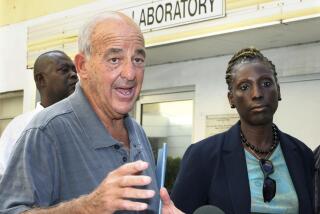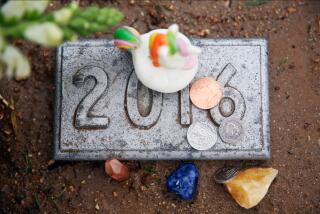Decline on autopsies may obscure understanding of disease
- Share via
Television crime shows have helped popularize autopsies, but in reality these postmortem exams are becoming rarer every year. Today, hospitals perform autopsies on only about 5 percent of patients who die, down from roughly 50 percent in the 1960s. That’s unfortunate, say experts, because details about the cause of death can be illuminating for both families and hospitals, even if they don’t turn up an undiagnosed ailment or other new information about the cause of death.
Kristine Johnson’s father, Nathan Johnson, developed early-onset Alzheimer’s disease and died last August, five years after having received that diagnosis at age 52. He worked as a lineman for a power company near the family home in Waterford, Conn., and had on occasion been injured by powerful jolts of electricity, says Kristine, who is 36. She hoped that an autopsy would provide some answers, possibly related to injuries he sustained on the job, about why he developed Alzheimer’s at such an early age. (Most people who develop Alzheimer’s do so after age 65; only about 5 percent of cases are early-onset.)
Unfortunately, the autopsy didn’t give them any new clues, and she and her brother, Nathan Jr., 39, are left wondering about their own risk, since family history often plays a role in the disease. Even so, she said she thinks it was worthwhile to attempt to shed light on her father’s disease through an autopsy. “Anything we can do to help discover the cause and fight this horrendous, nasty disease, we’ll do it.”
Autopsies play a critical role in helping to advance understanding of the progress of a disease and the effectiveness of various treatments. At the same time, they may identify medical conditions that clinicians and high-tech imaging miss or misdiagnose.
For example, Elizabeth Burton, deputy director of the autopsy service at Johns Hopkins Hospital in Baltimore, recalls that when she autopsied a 50-year-old alcoholic patient, what appeared to be cirrhosis of the liver was actually cancer.
Autopsies can also reveal a range of conditions with hereditary implications, from cancer to cardiovascular disease, says Burton, who is a physician.
Current research is scarce, but in 1998 the Journal of the American Medical Assn. reported that autopsy results showed clinicians misdiagnosed the cause of death up to 40 percent of the time. With the increasing use of high-tech imaging equipment, “maybe the error rates are better now,” says George D. Lundberg, who wrote the JAMA piece while he was the editor of that journal. (He is now an editor-at-large at MedPage Today a medical news Web site.)
Until 1970, hospitals had to autopsy at least 20 percent of their patients in order to remain accredited. Once that requirement was dropped, autopsy rates began to fall, due to lack of direct funding, fear of litigation and increasing reliance on technology as a diagnostic tool, among other reasons.
As autopsies have become rarer, so has research comparing diagnoses before and after death. Today, about 40 percent of hospitals don’t perform autopsies at all, says Burton, who is an expert on autopsy trends.
When an autopsy is requested, the pathologist first conducts an external examination of the body to look for injuries and signs of disease. Then the pathologist makes two incisions, one at the back of the head and one in the chest and stomach area, and takes samples of organs, tissue and blood, among other things. The pathology team does a microscopic analysis of the samples
and may do genetic, drug and other tests as well. They write a report explaining their findings. The whole process takes the better part of a day.
In the case of an unnatural death -- a homicide or an accident, for example -- the state medical examiner or coroner may require an autopsy. But in cases where there’s no evidence of foul play or unnatural death, the decision to request an autopsy is up to physicians and family members of the deceased.
In theory, the federal government pays hospitals to perform autopsies through the fixed payments it makes to the Medicare program. In practice, however, those funds generally don’t trickle down to the pathology department. But in general if a family requests an autopsy, a hospital will often conduct it at no charge. The hospital can also arrange for one to be conducted elsewhere if it doesn’t perform them. Many hospitals will also perform autopsies on former patients gratis for some designated period of time regardless of where they died.
A small minority of hospitals these days charge families for autopsies, says Gregory J. Davis, a professor of pathology and laboratory medicine at the University of Kentucky. At $3,500 to $6,000 each, this can be a big deterrent. “In essence what they’re saying is, ‘We don’t want to do this,’ ” he says.
Disagreement within the family over whether to ask for an autopsy can create other hurdles. When Alan Schiller’s father died at home in his bed of unknown causes a few years ago at age 85, Schiller, former chairman of pathology at Mount Sinai School of Medicine in New York, didn’t object when his brother said he didn’t want an autopsy to be done. His brother felt, as people often do, that their father had suffered enough and shouldn’t, even in death, have to undergo another procedure. Looking back, however, Schiller has mixed feelings. “I didn’t fight it . . . but I had some guilt,” he says. “We never really knew what terminated my father.”
-Have questions for Michelle Andrews? Write to her at [email protected].
-Andrews writes for Kaiser Health News an editorially independent news service and a program of the Kaiser Family Foundation, a nonpartisan healthcare policy research organization. Neither Kaiser Health News nor the foundation is affiliated with Kaiser Permanente.
More to Read
Sign up for The Wild
We’ll help you find the best places to hike, bike and run, as well as the perfect silent spots for meditation and yoga.
You may occasionally receive promotional content from the Los Angeles Times.










